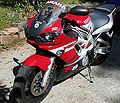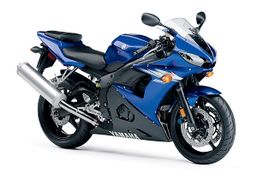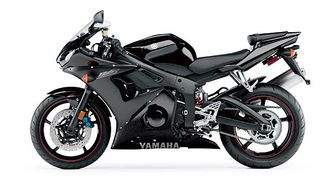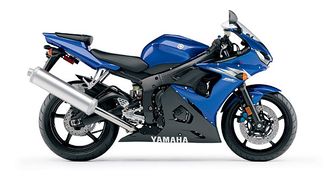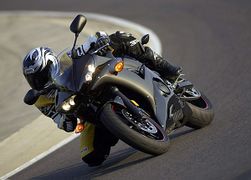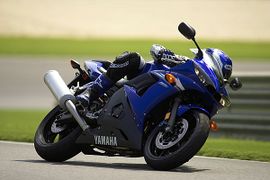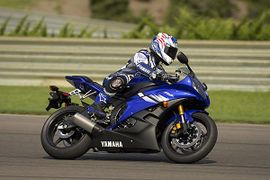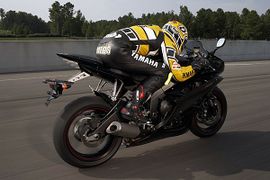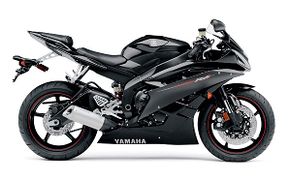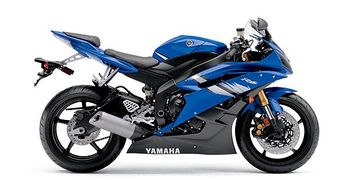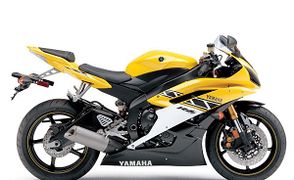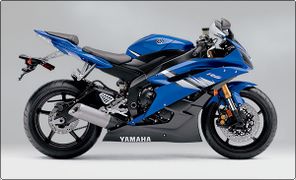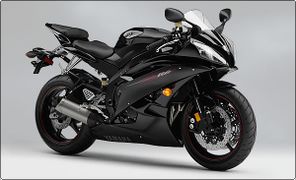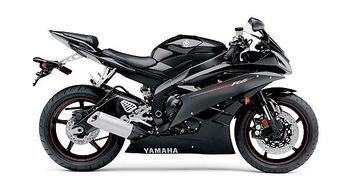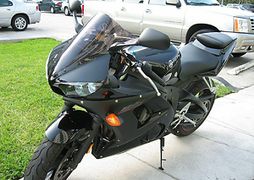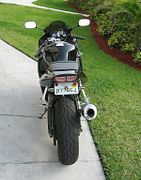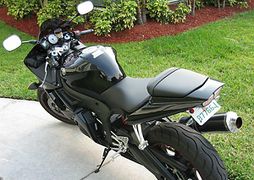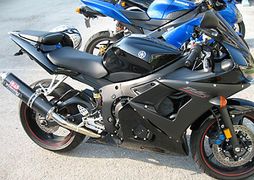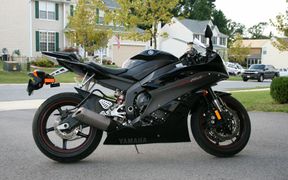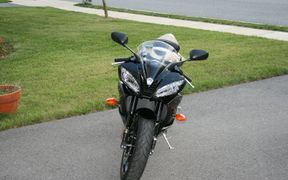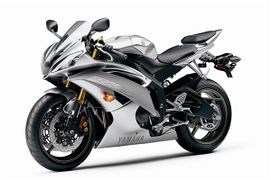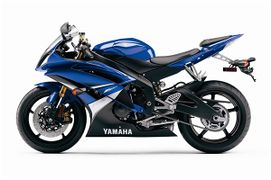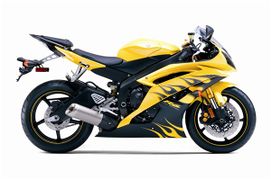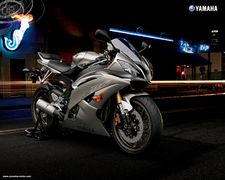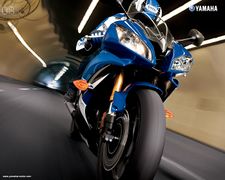Yamaha YZF-R6
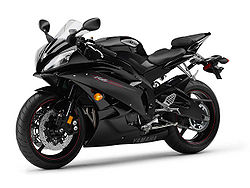 |
|
| Yamaha YZF-R6 | |
| Manufacturer | |
|---|---|
| Also called | YZF-R6 R46, YZF-R6S, YZF-R6 WGP50th Anniversary, YZF-R6 WGP 50th Anniversary, YZF-R6 Racing, 600 R6 |
| Production | 1999 - 2019 |
| Class | Sport Bike |
| Engine | in-line four, four-stroke |
| Bore / Stroke | 67.0mm x 42.5mm |
| Compression ratio | 13.1:1 |
| Top Speed | 155 mph (250 km/h) |
| Horsepower | 120.83 HP (90.1 KW) @ 14500RPM |
| Torque | 49.79 ft/lbs (67.5 Nm) @ 10500RPM |
| Air Filter | K&N YA-6001 `99-05[1] |
| Ignition | tci: transistor controlled ignition |
| Spark Plug | NGK CR9EK `99-00[2] |
| Battery | YUASA YT12B-BS `99-00[2] |
| Transmission | Gear box: 6-speed Final Drive: chain |
| Final Drive | Chain: 532 `99-00[2] |
| Suspension | Front: 43mm kyb® inverted fork, 3-way adjustable Rear: kyb® piggyback shock, 4-way adjustable |
| Brakes | Front: double disc. abs. floating discs. four-piston calipers. radially mounted. Rear: single disc. 220mm hydraulic disc; abs |
| Front Tire | 120/70-zr17 |
| Rear Tire | 180/55-zr17 |
| Wheelbase | 54.09 inches (1374 mm) |
| Length | 80.31 inches (2040 mm) |
| Width | 27.8 inches (706 mm) |
| Height | 45.31 inches (1151 mm) |
| Seat Height | 33.5 inches (851 mm) |
| Weight | 356.93 pounds (161.9 Kg) (dry), 190.1 kg (wet) |
| Oil Capacity | 0.69 Gallon (2.60 Liters) |
| Oil Filter | K&N KN-204[1] |
| Recommended Oil | Yamalube 10w-40 |
| Fuel Capacity | 4.6 Gallon (17.41 Liters) |
| Fuel Consumption | 5.60 liters/100 km (17.9 km/l or 42.00 mpg) |
| Related | Yamaha YZF-R1 Yamaha FZ6 |
| Competition | Yamaha YZF-R6 Honda CBR600F Honda CBR600RR Kawasaki ZX-6R Ducati 749 Triumph Daytona 675 |
| Manuals | 2000 Yamaha YZF-R6 M Owners Manual 2001 Yamaha YZF-R6 N Owners Manual More Manuals |
Yamaha's YZF-R6 is a 600 cc sport bike, first introduced in 1998, updated in 2001, 2003, 2006 and revised in the years in between. It could reach a top speed of 155 mph (250 km/h). Max torque was 49.79 ft/lbs (67.5 Nm) @ 10500 RPM. Claimed horsepower was 120.83 HP (90.1 KW) @ 14500 RPM.
Engine[edit | edit source]
The engine was a liquid cooled in-line four, four-stroke. A 67.0mm bore x 42.5mm stroke result in a displacement of just 599.0 cubic centimeters. Fuel was supplied via a double overhead cams/twin cam (DOHC).
Drive[edit | edit source]
The bike has a 6-speed transmission. Power was moderated via the Wet Multi-plate clutch.
Chassis[edit | edit source]
It came with a 120/70-zr17 front tire and a 180/55-zr17 rear tire. Stopping was achieved via double disc. abs. floating discs. four-piston calipers. radially mounted. in the front and a single disc. 220mm hydraulic disc; abs in the rear. The front suspension was a 43mm kyb® inverted fork, 3-way adjustable while the rear was equipped with a kyb® piggyback shock, 4-way adjustable. The YZF-R6 was fitted with a 4.6 Gallon (17.41 Liters) fuel tank. The bike weighed just 356.93 pounds (161.9 Kg). The wheelbase was 54.09 inches (1374 mm) long.
Competition[edit | edit source]
The R6 is seen as a direct competitor to the 16500 rpm ZX-6RR by Kawasaki which comes equipped with a close-ratio transmission and a slipper clutch. The R6 addresses this competition with the higher horsepower and higher-revving engine on a vehicle that has a lower dry weight. As well as this improved engine performance, Yamaha also added a slipper clutch and significantly upgraded the suspension.
Retailing for $9199 in the United States, the new R6 is currently the most expensive middleweight superbike on the U.S. market. It also competes with the Suzuki GSX-R 600, the Honda CBR600RR, the Ducati 749 or the Triumph Daytona 675.
Specifications[edit | edit source]
- Engine
- 4-stroke liquid-cooled DOHC 600 cc in-line 4-cylinder 16-valve producing up to 97.8 kW (133 hp) @ 14,500 rpm
- Tires
- Dunlop Sportmax Qualifier (120/70 ZR17 on the front and 180/55 ZR17 on the rear)
- Front brakes
- Dual 310 mm discs with hydraulic calipers
- Rear brakes
- 220 mm disc with hydraulic caliper
- Front suspension
- Fully adjustable 41 mm inverted cartridge fork with separately adjustable high-speed, low-speed, and rebound damping
- Rear suspension
- Fully adjustable link Monocross with separately adjustable high-speed, low-speed, and rebound damping
- Transmission
- 6-speed close-ratio with slipper clutch
Engine Specifications[edit | edit source]
- Configuration
- 4-stroke liquid-cooled DOHC 600 cc in-line 4-cylinder 16-valve
- Cylinders
- 67 mm bore × 42.5 mm stroke (from 65.5 × 44.5 mm), 37.5 mm height piston skirts
- Head
- 11.5° intake and 12° exhaust valve angles (down from 14° both), aluminum valve retainers, two 27 mm diameter titanium inlet valves (from 25 mm), two 23 mm titanium exhaust valves (from 22 mm), 12.8:1 compression ratio (from 12.4:1), semi-hydraulic camchain tensioner
- Fuel
- chip controlled throttle, fuel injection system with secondary injector
- Aspiration
- straight induction,
- Exhaust
- titanium exhaust powervalve, triple three-way catalyser
- Output
- static : 93.4 kW (127 hp) @ 14,500 rpm, 66 Nm (MEP 14,3 bars) @ 12,000 rpm
- Dynamic : 97.8 kW (133 hp) @ 14,500 rpm, 68 Nm @ 12,000 rpm
- Redline
- 16,200 rpm resulting in a 23 m/s piston speed
Controversy[edit | edit source]
Yamaha advertised the R6 as capable to running at up to 17,500 rpm. This is 2500 rpm higher than the previous R6 model and it is the highest redline of a widely distributed production four-stroke engine (the Honda CBR250RR had a reputed redline of 18,500 rpm but was originally distributed only in the Japanese market). Such a high speed is near to levels known only in Formula One engines, where valve springs stress problems led to the adoption of pneumatic return at more than 19,000 rpm.
But it was widely reported that the new 2006 YZF-R6's motor did not have this redline level and was closer to around 16,200 rpm. In February 2006, Yamaha admitted the bike's true redline was more than 1,000 rpm lower than advertised and offered to buy back any R6 if the customer was unhappy.
This is not the first time a sportbike's true redline has differed from it's redline shown on the tachometer. The 2005 Kawasaki ZX6RR has an indicated redline of 16,500 rpm on its tachometer. However, during a SportRider magazine test in the fall of 2005 when testing the ZX6RR on a dynamometer it wasn't possible to get the motor to rev past 15,000 rpm. The tachometer on most sportbikes is off by a certain percentage. New 600 cc motorcycles are revving up higher and higher, and while the percentage of tachometer error might not change, the error in number of RPMs increases.
1999[edit | edit source]
2000 Yamaha YZF-R6[edit | edit source]
The smaller brother of the flagship R1, the 1999 Yamaha YZF-R6 is an equally enthralling bike. Packing a 599cc displacement for its 4 in-line engine, it is capable to produce a peak power of 120 hp and 92 Nm of torque. The power to weight ratio is lower than that of the R1, as the R6 tips the scales at 169 kg.
Nevertheless, the 1999 R6 is no to for inexperienced riders, as it has been loaded with state-of-the art technology, and is an adversary to be reckoned with both on the track or on the street.
2001[edit | edit source]
2002[edit | edit source]
2003 Yamaha YZF-R6[edit | edit source]
Great looks, even greater power and maneuverability to match them both, the 2002 Yamaha R6 has them. If superbikes are not your cup of tea and would rather go for the middleweight class, then this supersport machine is one of the top choices. The frame of the bike is manufactured using the Controlled Filling Die Cast technology, resulting in a structure which is stronger and stiffer, while being lighter.
With only 2 welds replacing the usual 16 which were usually needed, it's obvious we're dealing with a piece of truly high-tech engineering. Add in all the experience in manufacturing high-performance sport bikes Yamaha is famous for, for a truly stunning supersport experience.
2004 Yamaha YZF-R6[edit | edit source]
The 2003-made R6 gets a new injection mapping, now able to provide more power and torque in the low- and mid-range rpm areas, and this spells excellent streetability. The engine works smoother thanks to the revised exhaust canister, while riding in the high-rev range will provide an exhilarating experience, both on the track and through the twisties.
With a Deltabox III frame making the whole machine stiff and narrow, the 2003 YZF-R6 is more aerodynamic and even more eager to make credible claims to any supersport crown available on earth.
2005 Yamaha YZF-R6[edit | edit source]
The smaller brother of the R1 superbike, the supersport-class 2004 YZF-R6 brings just about the same level of performance and thrill, of course keeping the displacement difference in mind. The engine of the R6 received multiple revisions for this model year, and they include new camshafts, bigger throttle bodies (now 40mm), better injection and new intake funnels.
2005 also brings in a new fork and a new rear suspension linkage, which triggered a redesign of the Deltabox III frame. Add in bigger but lighter 310mm brake discs, dual radiator fans, a revised headlight lens and overall reduced frictional energy loss.
2006 Yamaha YZF-R6S[edit | edit source]
If the 600R was not sporty enough for you, both tech-wise and from a design point of view, Yamaha has prepared a Street version of the R6 for you, sporting almost identical bodywork and character, though with a more "civilian" engine and transmission behavior.
The 2006 R6S may be hard to tell among other R6 machines, but the main thing to indicate the version is the fork. The racey R6 comes with upside down forks, while the suspension of the S version is a normal one. Several other tech details keep the R6S ore on the road side of riding, While a full-our R6 would beat the R6S hands down, the latter is a blazing fast machine nevertheless.
2006 Yamaha YZF-R6[edit | edit source]
The 2005 R6 comes loaded with a ton of high-tech features which are taking peformance to the next level, adding even more to the spectacular on-road stance and maneuverability, while offering riders a more precise feel behind the bars, on both the track and the streets.
A MotoGP-derived titanium exhaust with a EXUP valving is standard, just the the electronic throttle control and the back-torques limiting slipper clutch. The base mode, 2005 R6 comes is Team Yamaha Blue/White and classic Raven black.
The YZF-R6 becomes the first production motorcycle to use a “fly-by-wire” throttle control system rather than traditional cables: Yamaha Chip Controlled Throttle (YCC-T).
2007 Yamaha YZF-R6S[edit | edit source]
A more civilized, street-friendly version of the R6, the 2007 MY R6S brings a new definition to the term "do it all sport bike". Unlike its supersport-derived sibling, the R6S has traditional forks and the 4 in-line engine also got a special set of tweaks to make the bike feel more reassuring and performing better, even though you'll not be revving it up just as high as the R6's.
You can think about the R6S as a "civilian" alternative to the track-focused YZF-R6.
2007 Yamaha YZF-R6[edit | edit source]
R1's smaller sibling, the 2007 R6 was not forgotten when upgrades hit the production line. This exceptional, 16,000 rpm-redlined engine is capable to deliver breathtaking performance both on the track and the street, though the former is its true home. Multiple engine and suspension tweaks have added to the handling feel of the R6, and the current version offers more dependability.
The bodywork is similar to that of the R1, with Formula 1-inspired aerodynamically-efficient solutions and carefully designed lines to maintain the looks in the to-die-for zone.
2008 Yamaha YZF-R6[edit | edit source]
One of the most popular supersport-class bikes in the world, the Yamaha YZF-R6 carries on the heritage of the family through the 2008 model year. One of the most exciting track bikes, the R6 is also a fun machine when ridden on the street. Agile and powerful, the 2008 MY R6 also packs a huge amount of high-tech parts, including ride-by-wire and an all-new MotoGP-inspired frame.
Variable intake stacks are standard equipment for the newly-revised engine, while the new Ram Air system force feeds cool air to the engine through a straighter line. The brakes and suspensions got an overhaul as well, just like the headlights and the comprehensive dashboard.
2008 Yamaha YZF-R6S[edit | edit source]
The untrained eye will easily mistake the R6S for its track-focused R6 sibling, but despite the similarities, these are two different beasts. The 2008 MY R6S is the "urban" version of the R6, with a revised riding position and a slightly more tamed engine, with the peak torque and power point set lower in the rev range.
This bike is also a machine not intended for novice or inexperienced riders, as it packs almost as much grunt as the R6, and shares most of its components with the track-focused machine. The different shape of the central air intake and the casual (non-inverted) forks are the main elements which will allow you to recognize the R6S.
2009 Yamaha YZF-R6[edit | edit source]
The 2009 MY Yamaha YZF-R6 shares the updates with its liter-class sibling, and brings forth a new, more powerful engine, loaded into a new, optimized frame with a design oriented on higher sporty performance. The higher-revving power unit has a new mapping and is equipped with a high-performance slipper clutch to help riders when they brake hard or downshift.
And to keep weight to a minimum, Yamaha has also equipped the 2008 MY YZF-R6 with a special lightweight 525 O-ring chain.
2009 Yamaha YZF-R6S[edit | edit source]
The YZF-R6S is the more streetable version of the R6, packing better comfort for longer rides and increased all-day, all-round convenience. However, the 2008 MY YZF-R6S is not an easy-to-tame beast, as it still retains much of the nerve of its supersport, track-oriented sibling.
Despite the somewhat similar looks of the current R6S and older R6 machines, the casual "upside up" forks are the easiest way to tell the two apart.
2010 Yamaha YZF-R6[edit | edit source]
Ready for the race track but at the same time a comfortable presence on the street, the 2010 MY Yamaha YZF-R6 introduces a new silencer for reduced noise, a new ECU mapping, revised intake funnels, a different airbox and a revised 4-into-2into-1 collector system.
Loaded with both electronics and parts which are directly derived from Yamaha's racing program, the YZF-R6 is a machine intended for experienced riders who can master the explosive power and torque this bike can deliver at a twist of the throttle.
2011 Yamaha YZF-R6[edit | edit source]
The 2011 MY YZF-R6 is a great way to have sporty fun on the wide open roads, as it incorporates a lot of racing technologies in a supersport package with premium handling and power to make even the most seasoned riders smile in thrilling pleasure. A lightweight construction keeps an eye on the power to weight ration and ensures the outcome is a pure sport-blooded one.
Not exactly a machine for beginners, The 2011 R6 comes with adjustable suspensions which can ease a bit the handling and make the bike more forgiving. For those in search of a two-wheeler for high-paced fun and which can be fun and usable for both daily riding and track days, the 2011 MY R6 is one worthy choice.
2012 Yamaha YZF-R6[edit | edit source]
The 2012 MY YZF-R6 is loaded with top-notch technologies which are aimed at providing a more rewarding experience on two wheels, whether for daily riding or track days. Sporting the acclaimed Yamaha Chip-Controlled Throttle, the new R6 provides precise fuel delivery in all scenarios with a flawless response, a great match for the variable intake tract which grants the optimal cylinder filling for a greater powerband.
The high-compression engine delivers awesome response and lets the Supersport DNA shine through. The lightweight build comes with adjustable suspensions and powerful 310mm rotors for exceptional stopping power. For those who think a liter-class machine is way too much, the 600cc-classs 2011 R6 might just fit the bill.
2013 Yamaha YZF-R6[edit | edit source]
Developed using countless years of racing expertise, the Supersport-class Yamaha YZF-R6 reaches now new performance boundaries, pushing things even further into the reals of pure road-aggression adrenaline-drenched riding. Less intimidating as a liter-class superbike such as its bigger sister, the R1, this machine is still highly-capable to deliver awesome speed and a most rewarding experience for the sporty rider. With chip-controlled intake and throttle, the power delivery is precise and has no lag: just like a racing bike should be like on the track.
However, thanks to the adjustable suspensions, this bike is also suitable for daily riding through the city and around it, and it can be a fun commuter for reasonable distances. And with a torque-limiter slipper clutch, high-speed braking and downshifting are now safer and more efficient, improving both track and road riding.
2016 Yamaha YZF-R6[edit | edit source]
One ride on the R6 lets you know that this bike was born on the racetrack. Its MotoGP-bred technology is tuned to give you the kind of outstanding engine and chassis performance usually reserved for professional riders.
Its ultra-high-revving short-stroke engine unleashes dazzling power, made even more responsive by the state-of-the-art YCC-I (Yamaha Chip Controlled-Intake) and YCC-T (Yamaha Chip Controlled-Throttle).
2017 Yamaha YZF-R6[edit | edit source]
Already one of the most nimble machines in the supersport class, 2017 brings additional mass-centralization to the proven R6 package along with updated suspension, for improved front-end feedback and greater cornering confidence.
In Media[edit | edit source]
- Lucifer
- Hawaii Five-0
- Person of Interest
- Rosario Tijeras
- Russkiy dubl
- NCIS
- Timeless
- Taken: The Search for Sophie Parker
- Fina Estampa
- Biser Bojane
- Burn Notice
- Torque
- El cuerpo del deseo
- Raising Hope
- Ascetoholix: Na Spidzie
- Houston feat. Chingy, Nate Dogg & I-20: I Like That
- Motorweek
- Chasing Life
- Diversão & Cia
- Gulczas, a jak myslisz...
- Pars: Kiraz operasyonu
- Tusenbröder
- The Inspector Lynley Mysteries: A Suitable Vengence
- Gomorroide
- Trzeci oficer
- S.W.A.T.
- NCIS: Los Angeles
- Reuter & Skoog
- Camping paradis
- Crimini
- The Player
- Make-Out with Violence
- Castle
- Dus
- Azuloscurocasinegro
- Biker Boyz
- Deja Vu
- Une histoire à ma fille
- Gorodskie shpiony
- Ulitsy razbitykh fonarey
- Inspektor Kuper
- Cops
- Domangja: Plan B
- Tierra de pasiones
- Smeris
- À fond
- I Cesaroni
- Psych
- Rodina zhdyot
- Eva La Trailera
- Down to Earth
- Negra consentida
- El Clon
- Key and Peele
- I Hate California: San Francisco
- Kapkan dlya killera
- Rollin' With The Nines
- Ojciec Mateusz
- Notting Hill
- A Good Day to Die Hard
- Loick Essien feat. Tanya Lacey: How We Roll
- Vivo en Argentina
- Girls Of Mischief
- Mischief Invasion
- Adrenalin Crew
- Getaway in Stockholm 8
- Shottas
- Amor en custodia
- Veronica Mars
See Also[edit | edit source]
External links[edit | edit source]
- Official site : 2006 YZF-R6 Yamaha USA
- Technical details : 2006 Yamaha YZF-R6 : First look, Motards-Online, 2005-10-10, accessed 2005-12-28
- Traditional Valve Springs and Higher Redlines, Motorcycle Daily, Dirck Edge, 2005-09-28, accessed 2005-12-28
- New Yamaha R6 Does Not Rev To 17,500 rpm After All Motorcycle Daily, Alex Edge, 2006-02-01, accessed 2006-02-15
- Yamaha Offers Buyback Option For 2006 R6 Owners Motorcycle Daily, Alex Edge, 2006-02-14, accessed 2006-02-15
- Discussion Forum : R6Messagenet.com
References[edit | edit source]
- ↑ 1.0 1.1 2019 K&L Supply Co Catalog. K&L Supply Co. 2019.
- ↑ 2.0 2.1 2.2 2019 Western Power Sports Catalog. Western Power Sports. 2019.
| ||||||||





